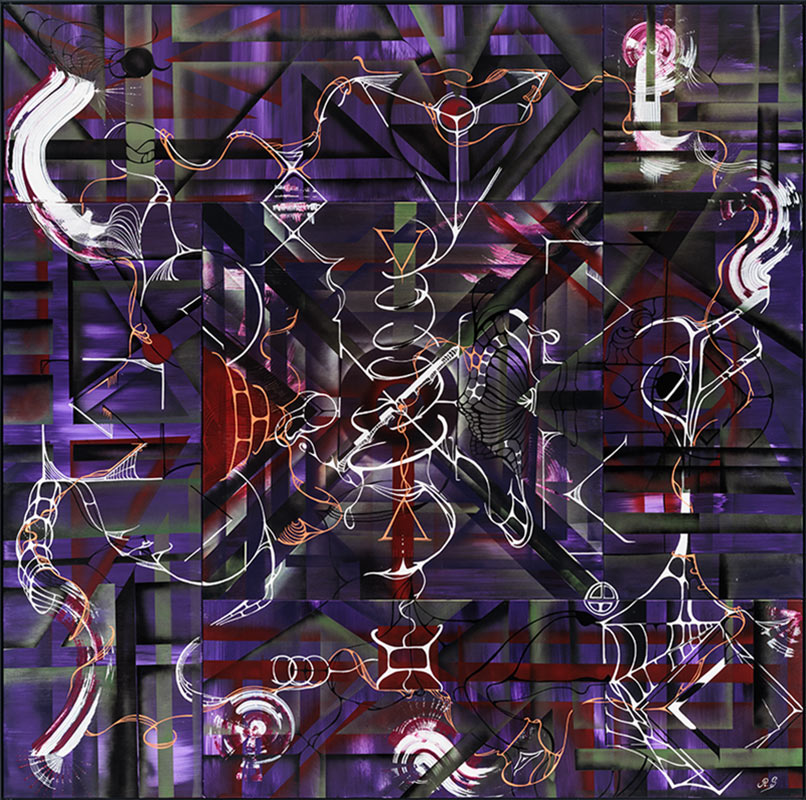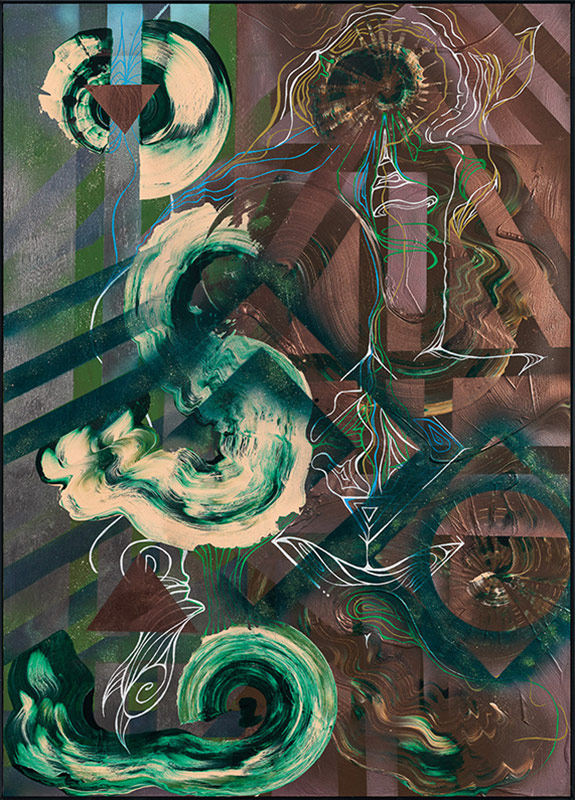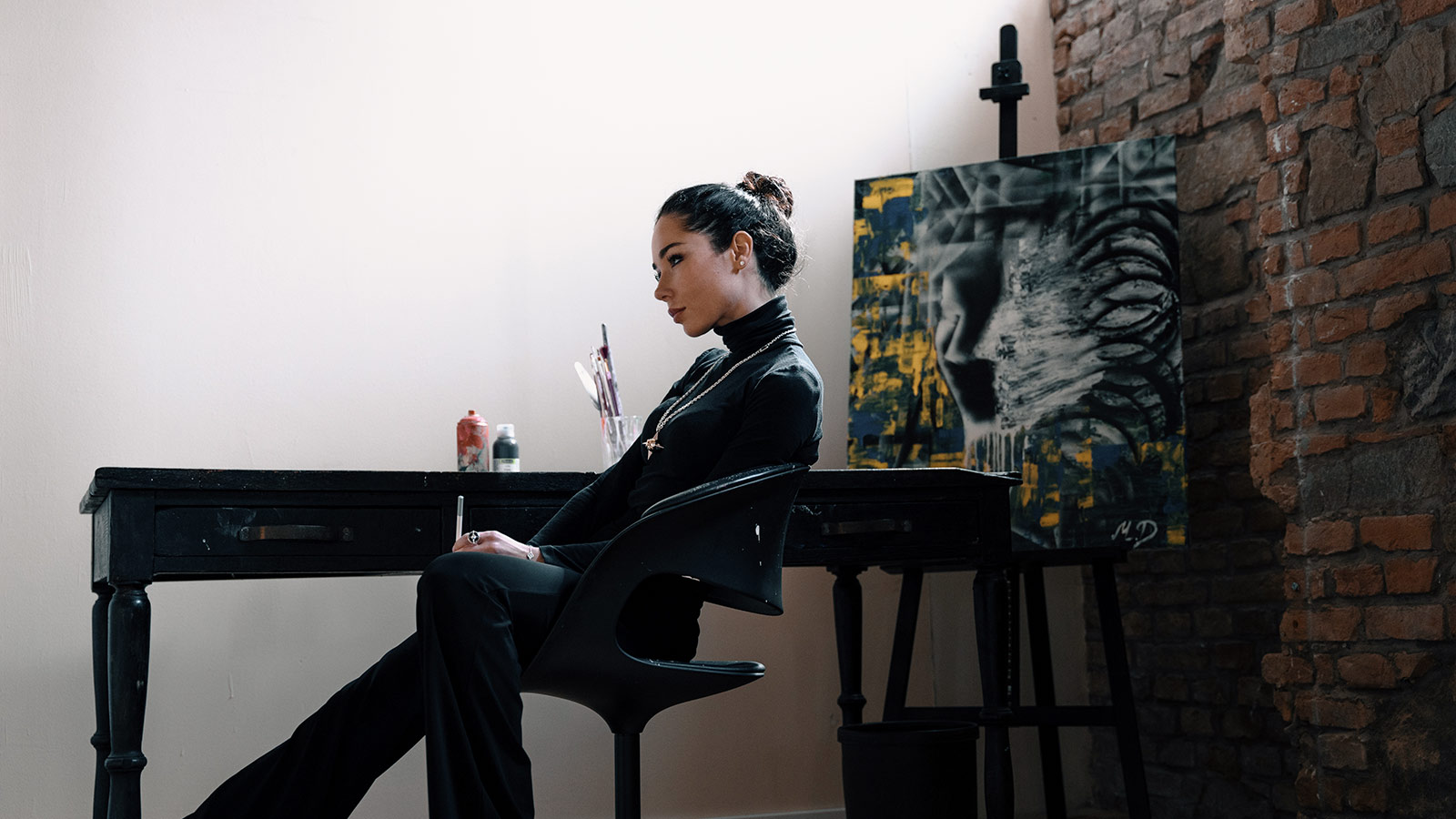Art is more than just decoration. In the case of Rita Sabo, the work becomes a social critique and a testimony to a time in which we find ourselves in the midst of the sustainability struggle. In her “Sacred Planet” series, the artist processes her thoughts and uses paint and brushes to call on us to take care of our planet.
FACES: As an artist, you have the opportunity to convey your view of the world to people. Your “Sacred Planet” series, which was also recently exhibited in Venice, deals intensively with the topic of sustainability. Why is this so important to you?
Rita Sabo: Our world has never been so fast, so superficial and so much in flux as it is right now. We live in a constantly changing world and society, and I think it is extremely important not to lose our roots despite all the problems and changes. My art helps people to reflect on their origins.
F: Art is always a testimony to the times, and your works embody the problems we have with our world. What statement are you making with your works?
Rita Sabo: I very much hope that my works will be seen as a wake-up call and that we will look back on them in a few years’ time knowing that we were able to overcome the crisis and embark on a positive path as a society.
The “Sacred Planet” series
F: In “Sacred Planet”, you deal in particular with the topic of sustainability. Are there any other topics that you would like to take to heart for another series?
Rita Sabo: DNA, our origins and our planet are matters close to my heart. There are so many individual topics in it that I still want to work on, it can be built on again and again.
F: Not only did your exhibition bear the title “Sacred Planet”, you actually created a work of aluminum with the same name. What are you trying to say?
Rita Sabo: This is a symbol of the worldly power of creation and the interconnectedness of our universe. It has never been more important than today to love, honor and protect our planet; after all, we only have this one earth, which is the basis of our lives. The pedestal for “Sacred Planet” is made of old Venetian wood with numerous wormholes and provides a warm contrast to the cold aluminum.
F: Your exhibition “Sacred Planet” took place last summer in the famous Biblioteca Nazionale Marciana directly on St. Mark’s Square in Venice. Does the city of Venice have a special meaning for you?
Rita Sabo: Venice is very important to me, as this place is the starting point of the love between my husband and me. My love of Venice also inspired my daughter’s name. (Venezia; editor’s note)

Symbols from Greek mythology and the Celts
F: Symbolism is a big part of your work. Which symbols are particularly important to you?
Rita Sabo: I use numerous symbols from Greek mythology and also from the Celtic world. Again and again you will recognize the pineal gland, which is also known as the third eye. The colors are also particularly important to me. I use green, for example, as the color of the heart, which comes to the fore in many of my works.
F: You cheerfully mix symbols from Celtic with others from Buddhism. How do you put them together?
Rita Sabo: I think a lot about which symbols belong together and how they fit together. In my opinion, all symbols and signs were created on our earth and are therefore part of our world, which is why I see no problem in connecting them with each other.
F: In addition to symbolism, the concept of sacred geometry also plays a major role in your art. Can you explain what this means and what fascinates you so much about it?
Rita Sabo: By chance, I stumbled across a video on sacred geometry that immediately blew me away. I am always looking for more, because I am convinced that there is more than what we perceive. Sacred geometry is the theory of the structure of the world, which is reflected in everything: in the structure of buildings, in plants, in the human face or in art. The
The golden ratio is something like the basis of sacred geometry.
F: Your artworks often consist of several canvases. Why?
Rita Sabo: The world consists of several parts – just like my pictures. I also love working like this: on several canvases at the same time, sometimes overhead and from several perspectives, so that I can put the work together like a puzzle at the end.
F: How do you come up with the names of your paintings, and do you perhaps already know at the beginning what you will call your work?
Rita Sabo: No, at the beginning of the process I have no idea what the work will be called when it hangs on the wall. I spend a lot of time thinking before I name my pictures – it’s a difficult process for me because my works have a very deep meaning. I let myself be inspired by texts and poems, sometimes I do even more in-depth research on the themes that I use in my pictures, and suddenly I have an idea for a suitable name.
First the research, then the craft
F: How important is research in your work process?
RS: Research is an essential part of my work. I deal intensively with topics such as sustainability issues before I capture them on canvas in the form of my art. Only after I have informed myself in detail do I begin the purely intuitive work of applying the paint to the canvas.
F: How would you describe the way you work?
Rita Sabo: I work extremely intuitively and in a flow. I do not refer to a classical concept, but rely on the symbology that I transfer from the past to the present and thus also transcend into the future. At the same time, I sometimes give old symbols new meanings. Before I embark on a work, I think about what I want to say with it; that is also a kind of concept, but not one that I then follow step by step.
F: How long does it take you from the white canvas to the finished work?
Rita Sabo: If I work every day, it takes about a month, although this varies from picture to picture and can sometimes take longer if it’s a really big work. I work in several layers, which have to dry before I can continue with another layer.
F: When do you know a painting is finished?
Rita Sabo: As soon as I look at my picture and realize that everything makes sense to me. For me, it feels like I’m reading a story in a book. However, this process can take weeks. I only seal the picture when everything is right for me.
Art is both talent and craft
F: You have studied at several art schools. How much does art have to do with talent and how much with craftsmanship?
Rita Sabo: Art involves both talent and craftsmanship. Both components are important, but I believe that art can also be learned. In general, however, I would say that talent makes up maybe 30 percent, the rest is learning a craft. And in my opinion, it’s very important not to be lazy!
F: How do you look back on your beginnings as an artist?
Rita Sabo: Everything had to be the way it was for me to be where I am today as an artist. I firmly believe that. It is particularly exciting for me to recognize my own development in my works. I used to approach my art more light-heartedly than I do today, where I think much more, research more meticulously and work more precisely.
F: How should we imagine a day in your life as an artist?
Rita Sabo: The older I get, the more organized and strategic I become. This is certainly also due to the fact that I am not only an artist, but also a wife and mother of a young daughter. I usually structure my days very precisely and set the hours in which I work on my art. But every now and then I also have my wild phases when my creative impulses get the better of me and I run straight to the studio to realize my ideas.

The dear muse and the sources of Rita’s inspiration
F: What do you do when the muse doesn’t kiss you?
Rita Sabo: Putting pressure on people doesn’t work for me. My art needs its space. From my experience, I know that it helps me to start the process anyway, to become one with it, to really merge with it in order to bridge creative lulls.
F: What are the sources of your inspiration?
Rita Sabo: Music and traveling help me a lot to be inspired. I love electro-house music, but I also enjoy listening to classical music when I paint.
F: Electro house and classical music – two extreme contrasts!
Rita Sabo: Exactly, and I love that! I love contrasts in life and in my work. Light and dark, black and white and color, they make up my art.
F: People can follow you on Instagram as you build up your pictures one concentrated brushstroke at a time. Does your daughter sometimes watch you do this?
Rita Sabo: I work in my own studio in Vienna and not at home. My daughter has already visited me there, but I try to keep her away from the paint as much as possible. But she always watches me draw at home, then sits down next to me and tries to create something too.
Practice makes perfect
F: What was your first exposure to art like?
Rita Sabo: As a child, I often painted and did handicrafts. I grew into art through my family, as we also used to live in Basel and always experienced the Art Basel art fair and numerous vernissages up close.
F: You have lived and worked in numerous cities such as Basel and Jerusalem. Is that reflected in your work?
Rita Sabo: All my experiences are reflected in my art. I associate great memories with each of these places, which have had a huge impact on me.
F: Where do you feel most at home?
Rita Sabo: No matter where I am in the world: When my family is with me, I feel at home. My heart is where my family is.
The biggest catalyst for Rita’s art is love
F: You once said that your greatest inspiration and the best catalyst for your art is love. Are there any other emotions that inspire you?
RS: Love is an incredible, beautiful emotion that carries an incredible creative power. Every kind of emotion is an inspiration – if you don’t feel anything, nothing can come of it.
F: Where is anger seen in your art?
Rita Sabo: Actually, nowhere at all. I would like to give the viewers of my works something positive to take away with them. I process anger or rage before I start painting, where I concentrate primarily on the positive emotions.
Follow Rita Sabo on Instagram and find out more about the artist on her website.
You can find even more interviews with exciting personalities here.
Teaser photo & photos: © Rita Sabo









